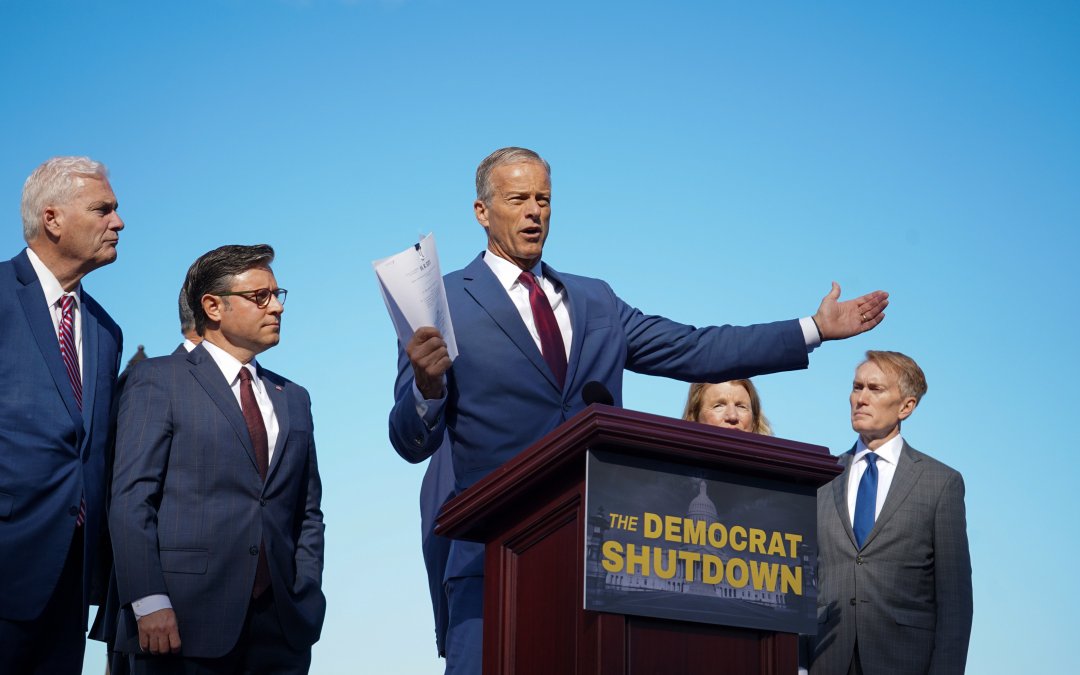WASHINGTON – Even before a convoy of congressional Republican leaders approached the lectern on Wednesday morning, the stage was meticulously set.
To one side stood a TV screen looping a clip labeled “Democrats on shutdowns in their own words.” In front of the lectern, a sign read “The Democrat Shutdown.” Behind the lawmakers, the National Mall — a scene House Speaker Mike Johnson (R-La.) quickly seized on, pointing out that visits to the Capitol have been suspended as the government shutdown sets in.
“Nearly half of our civilian workforce is being sent home,” Johnson said. “These are hard-working Americans who work for our federal government. Our troops and our border patrol agents will have to go to work, but they’ll be working without pay.”
The show of unity comes as both parties are attempting to seize the political advantage. Facing immense political pressure, party leaders on both sides of the aisle accused their opponents of making unreasonable demands that could set the stage for a prolonged battle.
House Democratic Caucus Chair Pete Aguilar (D-Calif.) and Vice Chair Ted Lieu (D-Calif.) fired back at their own press conference, castigating House Republicans for being “on vacation,” rather than negotiating with Democrats on Capitol Hill.
“House Republicans need to come back and work with Democrats and stop this Republican shutdown,” Lieu said.
Johnson kept the House out of session this week and sent Republicans home until after the shutdown deadline.
Both parties acknowledged the impact the shutdown will have on federal employees and government services such as the Food and Drug Administration, National Park Service and Supplemental Nutrition Assistance Program — or food stamps.
Republicans, however, attributed many of these effects to government shutdowns broadly, while Democrats targeted the Trump administration’s threats to inflict “maximum pain” on the federal bureaucracy in order to force Democrats to the negotiating table.
“The goal from Donald Trump and his administration has been all along to make this painful,” Aguilar said. “This isn’t about policy priorities.”
Office of Management and Budget Director Russell Vought and Vice President JD Vance have threatened imminent mass layoffs of federal workers if the government does not reopen, ratcheting up pressure on Senate Democrats to flip their vote. Thousands of employees at several agencies have already been furloughed.
Sens. Catherine Cortez Masto (D-Nev.), John Fetterman (D-Pa.) and Angus King — a Maine Independent who caucuses with Democrats — voted with Republicans on Wednesday to reopen the government. In separate statements, they cited the impending layoffs and President Donald Trump’s ability to exert significant power over executive agencies during a shutdown.
With Sen. Rand Paul (R-Ky.) defying his party, the Wednesday vote on the GOP’s proposal tallied 55-45. Republicans will now require five Democrats to break ranks to reach the 60-vote threshold to overcome a filibuster.
Most Senate Democrats, however, have held firm on their demands: reversing Medicaid cuts in the Big Beautiful Bill, permanently extending enhanced Affordable Care Act subsidies and preventing Trump from using rescissions to impound money appropriated by Congress.
Still, Republicans doubled down on their hardline position on negotiations, reiterating that the House GOP’s proposed stopgap bill would maintain government funding at current levels, without any “partisan tricks” or “poison pills.”
“This could have been avoided — (it was) totally unavoidable, and everybody’s now asking the question, ‘How does this end?’” Senate Majority Leader John Thune (R-S.D.) said. “Well, it ends when the Senate Democrats pick this bill up, passed by the House of Representatives, and vote for it.”


